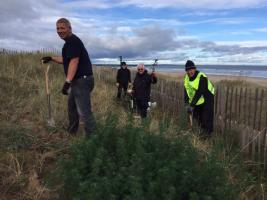Rona: island at the edge of the world - Speaker Anne Tait
Tue, Dec 14th 2021 at 7:00 pm - 9:00 pm
Reception - John Fernie,
Meal Payment - Angus Peters
Club members please log in for more information.
We were treated to a talk by member, Anne Tait, titled ‘Rona: island at the edge of the world’. Perhaps more precisely ‘The island of North Rona’, as there is a South Rona close to the northeast of Skye. South Rona is inhabited, albeit only two residents, North Rona is not. Paul Murton in his series based on Scottish Islands was one of the few people who have managed a landing. Anne’s talk was based on an essay by Kathleen Jamie, Scotland’s 4th Makar, written in 2006.
Taken on the Poplar Voyager skippered by Bob Theakston, Kathleen Jamie accompanied a group of ornithologists led by John Love to this remote part of the world. Like some of the others she suffered from a crossing of 6 hours in rough conditions. It was the same rough conditions that forced McLeod, the Steward of St Kilda to the same island in 1680. Rats from a passing ship had devoured the crops on the island and McLeod found only the remains of the 30 villagers who lived there. It took McLeod another 7 months to fashion a boat to enable an escape. The island was finally abandoned in the 1840s.
A seabird paradise Kathleen related in poetic terms being surrounded by Puffins and Guillemots, numbers decreasing due to the decline in sand eels, a staple diet of both birds. Careful not to disturb the birds and let the black backed gulls access their eggs, they ran the gauntlet of dive bombing Great Skuas. She related waiting at the base of a stone wall in the dead of night, hearing the eerie sound of Leach’s storm petrels leaving their lairs. These small birds need to be ringed and weighed before being let go on their way. Of course, the droppings of the many shags also had to be investigated!
Land that was once cultivated lies in undulating lazy beds close to the remaining village houses. Hobbit houses dug into the landscape with turf covered roofs. Apart from these, the only other buildings are the lighthouse and the remains of St Ronan’s Chapel. This Celtic church is thought to be the oldest Christian building still standing in Scotland. Having already encountered a pod of orcas on the inward journey, more marine life awaited on the rocky northern peninsula, called Fianuis , in Gallic meaning “testimony” or “witness . The home to grey seals, their numbers and condition needed to be assessed.
Preparing to leave the island after a short stay, conditions were favourable for a safe embarkation and journey back to Lewis. Kathleen finally mused on this desolate landscape offering a vision of what the future might hold for other parts of the world. Anne’s talk did justice to the prose of our National poet and received a sitting ovation from the members. John Fernie gave the vote of thanks.
'What We Do' Main Pages:
